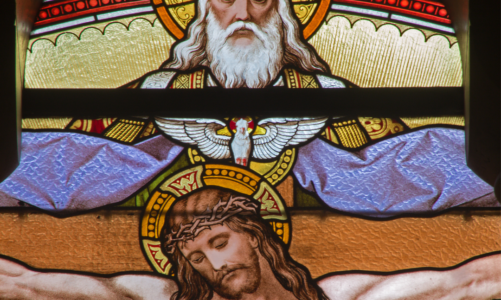Note: This post was written for a course in my Master’s program at Houston Baptist University. Because I received good feedback from my professor, I thought I’d share it here.
Those who use social media platforms such at TikTok, YouTube, and Facebook, have likely come across atheists preaching and arguing for God’s non-existence. While the reasons for atheism vary from person to person and from platform to platform, one of the most popular claims of the atheist is that science proves there is no God. Of these scientific claims, atheists frequently cite Charles Darwin’s law of natural selection as the best evidence for God’s non-existence. They claim that despite the intricate design, detail, purpose, and beauty of each individual species, Darwin’s law states that evolutionary creation is random. Atheists claim that because it is random, there can be no creator since those who create never do so randomly. This claim specifically objects to the theist’s teleological argument, the idea that God can be experienced and known through creation. This paper will defend the teleological argument by proving that natural selection is not random, and is instead, evidence for God’s existence. It will additionally argue for the teleological argument by focusing on the role of beauty when experiencing God in nature, and how the role of objective beauty points not just toward the existence of a God, but specifically the Christian God. Together these arguments will hopefully help our atheist friends, at the very least, reconsider their anti-God and/or anti-Christian views.
The heart of the teleological argument lies in the idea that the human experience of living in a universe that is so intricate in design, detail, and purpose that in our wonder and awe, we are led to rationally conclude that God fashioned it all. For example, consider a person witnessing, for the first time, the beauty of the milky way on a dark cloudless night up in the mountains away from all city lights. In this experience, that person would see, an apparent order to a vast, eternal, and ever-expanding universe. Additionally, the wonder and awe they receive from discovering that they exist and have a place in such order and beauty, along with the knowledge that all human objects must be created by someone or something, leads them to the conclusion that the universe must have been created by a superior intelligent designer, namely God. (It should be noted that the things that prompt a person to have an experience of God, like the milky way in the prior example, are termed as “natural signs”).
Although there are many who have come to believe in God through similar experiences to the one described above, and while many who have been moved to reconsider their position on God’s existence through the testimony of those who were converted through a teleological experience, skeptics do exist. Evans provides us with an example of a typical skeptic response. According to the skeptic, “Darwinian evolution involves randomness. Surely, one might think, a process that is the result of chance cannot be one that is guided by intelligence.”[1] Most skeptics when they speak about the randomness of Darwinian evolution are talking about natural selection in which a random genetic mutation occurs in a living organism. A logical and common response to the skeptic’s statement is to ask the skeptic what he or she knows about creating universes and where his or her universe creating expertise comes from. But, a more charitable example may be to respond with another Evans quote. The skeptics who believe that the genetic mutations in Darwin’s theory of evolution happen randomly are misunderstanding or misinterpreting the word “random.” According to Evans, “When scientists say that the genetic mutations are random, they are not saying that the mutations do not have causes, or even that they are completely unpredictable from the point of view of biochemistry. Rather, they mean that the mutations do not happen in response to the need of organisms.”[2] In other words, Darwin’s theory of evolution is completely compatible with the existence of God. The mutation theory, according to Evans, “simply offers a way that God can shape the process without doing anything miraculous, without violating the natural processes he maintains.”[3] For example, suppose a mutation appears in an organism. If the mutation is helpful to the organism, the mutation is likely to be produced in the next generation of organisms because it supported the organism in its survival. Likewise, if the mutation is unhelpful to the organism, it is less likely to be produced in the next generation of organisms because it did not support the organism in its survival. While the mutations appear to be random (perhaps later down the road, we will find out they are not), the process of natural selection is not random at all. In fact, it seems to be the exact opposite of random. Because of this, it is completely reasonable, even from a scientific view, to look at creation and determine a creator, God, exists.
Besides natural selection, another sign of order often dismissed and linked to the teleological argument, is beauty. Remember, the heart of the teleological argument lies in the idea that God can be experienced through natural signs. In addition to the intricate design, detail, and purpose found in natural signs, another major contributing factor to experiencing God through natural signs is found in their objective beauty. Because of this, when defending the teleological argument, it is important to consider and respond to the skeptic’s argument that objective beauty does not exist.
Going back to the idea of Darwinian evolution, it would be easy to say that there is no God, and that evolution has conditioned us to find certain things as beautiful. From an evolutionary perspective, it would make sense that those things found in nature which provide basic survival mechanisms such as food, water, and shelter, would be perceived as beautiful. Philip Tallon says it best in his chapter titled The Theistic Arguments from Beauty and Play, “Certain forms of nature have come to be associated with safety and food and therefore naturally provoke pleasurable responses… This attraction to certain natural phenomena would explain the seemingly universal perception of beauty in nature without the need to argue for beauty as an inherent property or, more specifically the investment of beauty in nature by God. Evolution has fitted our perceptions of beauty to nature because of some survival benefit.”[4] Though at first this seems to be true, when we consider that most people believe life threatening landscapes such as Death Road, Snake Island, and Skeleton Coast, are beautiful and that they furthermore, believe dangerous animals such as tigers, bears, dart frogs, and blue ringed octopi as beautiful, it would seem that Darwinian evolution fails to explain why humans find certain things beautiful, and once again, at first glance, seems to point toward a random universe with no God. But this simply is not true. In fact, when we patiently study the beauty in nature, we will find that it has order and the beauty within provides evidence for the Christian God. Let us examine further:
Tallon argues that “… aesthetic judgement requires development over time,”[5] “accurate aesthetic judgement requires, in a sense, a sort of ongoing sanctification of taste,”[6] and “the ultimate beauty of God challenges our natural ways of understanding beauty.” For instance, most people find death to be an ugly, gruesome thing, and in many ways, it is, but if we consider Tallon’s statements that aesthetic judgment requires development over time and that accurate aesthetic judgment require an ongoing sanctification of taste, we will see that someone who has a mature development of aesthetic judgment will find that beauty exists in something as seemingly horrific as death. For instance, when a flower dies, its seeds are dispersed into the air. When the seeds land on new ground, they will produce new flowers. Additionally, the body of the dead flower will fertilize the ground so that the life within the ground it fertilizes will continue to thrive. While the death of a beautiful flower may not appear to pretty at first glance, a close patient study of the flower’s death overtime will show there is beauty in death because it brings forth new life. The pattern and purpose of death bringing forth new life can be seen in all of natural creation.
But this notion goes even further. Beside the natural death of a plant, animal, or person fertilizing the ground to bring forth new life, the purposeful lying down of one’s life for a loved one can be seen in nature. On rare occasions, one can observe birds fighting to their own deaths to save their chicks. Elephants have been known to do the same. And of course, humans, especially parents, have been known to jump in front of bullets for their children. Furthermore, humans have even died for mere acquaintances or strangers. A famous and specific example of this is demonstrated through Saint and Catholic Priest, Maximilian Colbe, who offered to die in the place of a stranger when Nazi guards selected ten men to starve to death in a concentration camp during World War II. Although this act of purposefully dying to give another life could be seen as absurd, it can be argued through the examples above, that the objectively beautiful desire of giving life to others, even in death, can be seen in the design of observable nature—in humans and animals. Through the observable pattern of life and death seen in nature’s design, one can conclude that not only is there a purpose to death, but there is also an objective beauty in life itself and those things which give life. But how does this concept create evidence for not just any God, but the Christian God?
As stated in the Bible, the Christian God, “created the heavens and the earth” (Genesis 1:1), and “the free gift of God is eternal life in Christ Jesus our Lord” (Romans 6:23). The first quoted Bible verse’s meaning is clear. The Christian God created the universe. The second quoted Bible verse means that it is through the willful death of Jesus that we will be born into eternal life. While this paper does not have room to explain the evidence for this statement, we can see how the pattern of life and death found in nature reflects the Christian Gospel story of Jesus Christ dying to give his creation eternal life. Psalm 19:1 echoes this sentiment, “The heavens are telling the glory of God; and the firmament proclaims his handiwork.” In other words, the Christian God specifically can be observed in nature, providing evidence for the teleological argument. The life-giving effect of death in nature reflects the eternal life-giving effect of Christ’s death.
In closing, if the atheist’s conclusion of Darwin’s law of natural selection is right, and the evolutionary creation of the world is a random event based off mutations, then atheism is a reasonable conclusion to the teleological argument. However, a closer, patient, look at creation will show the opposite to be true. Natural selection is not random. Additionally, when one considers the role and pattern of objective beauty, especially in regard to the objective beauty of life and death, one can see how a close observation of nature can lead to not just knowledge of the Christian Gospel Story, but an experience of the Christian God in creation.
Bibliography
Walls, Jerry L, and Trent A Dougherty. 2018. Two Dozen (or So) Arguments for God: The Plantinga Project. New York: Oxford University Press.
[1]Ibid., 119
[2]Ibid., 120
[3]Ibid., 120
[4]Ibid., 329
[5]Ibid., 333
[6]Ibid., 334



